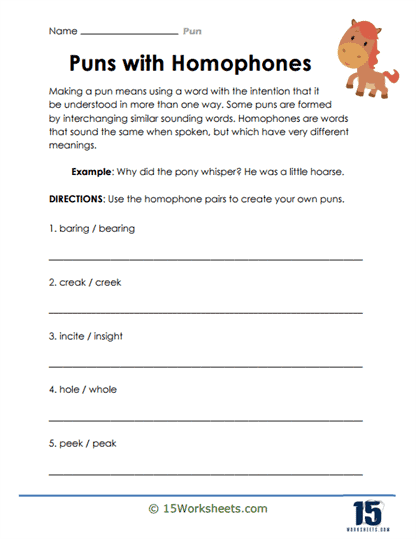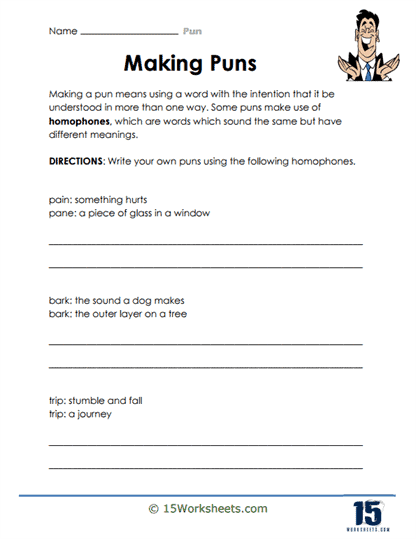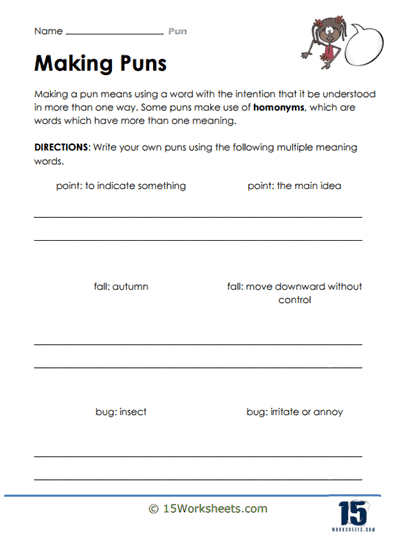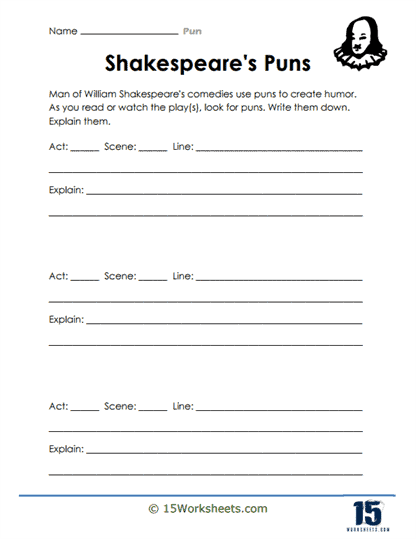Puns Worksheets
What is a Pun?
A pun is a form of wordplay that exploits the multiple meanings of a word or the similarity in sound between different words for a humorous or clever effect. It involves using a word or phrase that has more than one meaning, or using words that sound similar but have different meanings, to create a play on words and generate humor or wit. Puns are often characterized by their cleverness, wordplay, and the unexpected twist they bring to language.
Here is a quick example –
“I’m reading a book about anti-gravity. It’s impossible to put down!”
This pun relies on the multiple meanings of “put down” (as in placing something down and as in criticizing or belittling) to create humor.
Puns can be found in various forms of communication, including literature, jokes, advertising, and everyday conversations. They add a playful and witty element to language, often relying on the reader or listener’s ability to recognize the linguistic connection being made.
About These 15 Worksheets
These worksheets will help students understand and practice using puns in their own work. They consist of various exercises and activities related to puns, aimed at developing students’ understanding and ability to create puns. We have a wide range of how we introduce students to the use and role of pens in their own work. This include:
Pun Examples – We give several examples of puns to introduce students to the concept and illustrate how puns are created and used in different contexts.
Wordplay and Vocabulary Development – Worksheets may provide wordplay activities such as matching puns to their meanings, identifying puns within sentences or short passages, or creating puns based on given words or situations. This work can help expand students’ vocabulary by introducing them to words with multiple meanings or homophones (words that sound the same but have different meanings). Students may be asked to identify these words or come up with puns using them.
Context and Visual Representation – These exercises may require students to analyze puns in specific contexts and explain the intended meaning or humorous effect. Some worksheets incorporate visual elements, such as cartoons or illustrations, to accompany puns and help students understand the humorous connection between words.
What Is the Role of Puns in Literature?
The role of puns in literature is to add a layer of wordplay, humor, and linguistic richness to the text. Puns can serve various purposes within a literary work, such as:
Humor – Puns are often used to create comedic moments, light-heartedness, or to elicit laughter from the reader. They add a playful and entertaining element to the writing, making it more engaging and enjoyable.
Example 1: In William Shakespeare’s play Romeo and Juliet, Mercutio says, “Ask for me tomorrow, and you shall find me a grave man.” This pun on the word “grave” (meaning serious) and “a grave” (a burial place) adds humor to the scene despite its underlying seriousness.
Wit and Cleverness – Puns showcase the author’s skill and clever use of language. They demonstrate wordplay and linguistic dexterity, impressing the reader with the writer’s ability to create multiple meanings or connections between words.
Example 2: Oscar Wilde, known for his wit, said, “I can resist everything except temptation.” This pun on the word “resist” highlights Wilde’s cleverness by playing with the dual meanings of the word.
Double Meanings – Puns can convey a secondary meaning or a deeper message beyond the literal interpretation. They can add subtlety, irony, or complexity to the text, allowing for multiple layers of interpretation.
Example 3: In William Shakespeare’s play Hamlet, the line “I must be cruel, only to be kind” is a pun on the word “kind” (meaning both “gentle” and “kindest”). This pun emphasizes the conflict and complexity of Hamlet’s actions.
Characterization – Puns can be used to develop and differentiate characters by reflecting their wit, intelligence, or unique perspectives. The use of puns can provide insight into a character’s personality, wordplay skills, or their role within the narrative.
Example 4: In J.K. Rowling’s Harry Potter series, the character Albus Dumbledore often employs puns in his dialogue, showcasing his wisdom, intelligence, and sense of humor.
Literary Devices – Puns can serve as literary devices, enhancing the overall impact of a text. They can create memorable phrases, enhance the rhythm or flow of the writing, or contribute to the overall theme or tone of the work.
Example 5: In George Orwell’s novel Animal Farm, the phrase “All animals are equal, but some animals are more equal than others” is a pun on the concept of equality. The pun highlights the irony and hypocrisy present in the story’s allegorical critique of power and corruption.
These examples demonstrate how puns can be employed in literature to entertain, engage, create humor, convey deeper meanings, and contribute to the overall artistic and literary quality of a work.















